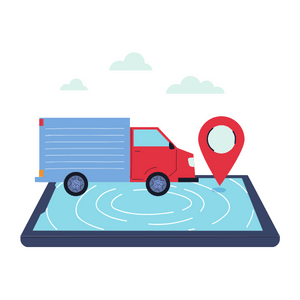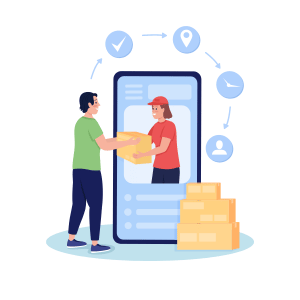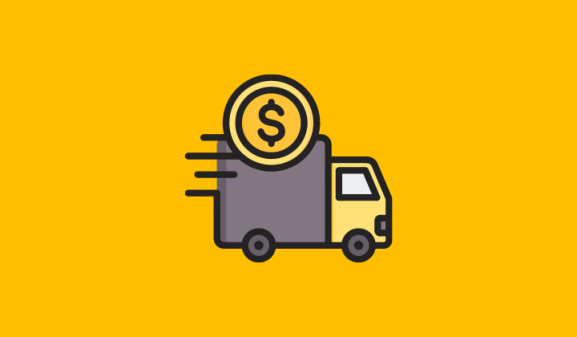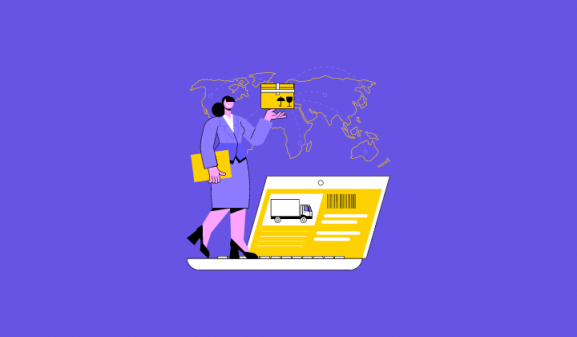Looking for “Logistics App Development cost” we are here to assist you every step of the way.
Is your company experiencing challenges with logistics management as it expands? Or, if you’re a numbers-driven analyst, are you struggling to stay on top of delivery schedules and find it challenging to track orders in real-time? Perhaps you’re concerned about the persistent increase in logistics costs and how it’s impacting your profitability. It could be any one of them related to inventory management, or tracking the idle hours of drivers and their performance.
Logistics app development is reshaping how goods and services are delivered across industries. With businesses striving for efficiency and speed, investing in a robust logistics app has become indispensable. Having a logistics app can effectively address all these concerns. With the help of logistics apps developed by the best app development companies, businesses can effortlessly navigate through supply chain disruptions and ensure timely delivery to meet customer demands.
The rise of logistics apps has brought about a revolution in the supply chain, transportation, and various industries as a whole. According to projections, the global logistics market is expected to reach a staggering US $7.9 Trillion by 2032. The app provides a wide range of benefits to businesses and assists them in adopting an optimal approach to achieve excellence.
Exploring these areas will help you understand the financial commitment required and how to strategically plan your project. Let’s dive into what makes logistics apps a worthy investment.
Why are Logistics Apps So Crucial Today?

Logistics apps are revolutionizing the way we think about transport and delivery. At its core, a logistics app manages the process of moving goods from one place to another in the most efficient way possible. These apps are not just about tracking vehicles; they integrate complex data analysis to optimize routes, manage inventory, and ensure timely delivery, making them essential in modern supply chains.
In an era where time is money, businesses are under increasing pressure to deliver faster and more reliably. A well-designed logistics app helps businesses meet these demands by improving coordination, reducing delays, and providing real-time updates. As we continue to see growth in online shopping and global trade, the role of these apps only becomes more central.
Also See! Is Custom CRM Development Cost More Affordable in 2024?
How Does a Logistics App Work?
Ever wondered what keeps a logistics app ticking behind the scenes? It’s like the brain of the entire operation, ensuring that every piece of the logistics puzzle fits perfectly. Essentially, a logistics app integrates several key components to streamline the movement of goods. Let’s break down this digital conductor’s role in orchestrating the symphony of supply chain activities.
Firstly, there’s the user interface (UI), the part you interact with. This is where the magic happens for users. Whether you’re a driver, a fleet manager, or an end customer, the UI is designed to be intuitive and responsive, giving you real-time updates like delivery tracking, route optimization, and more.
Then, there’s the engine under the hood – the algorithms. These algorithms are what make logistics apps truly powerful. They calculate the best routes, predict possible delays, and can even suggest alternative strategies to handle unexpected situations. This not only saves time but also reduces operational costs.
Lastly, there’s seamless integration with other systems. A logistics app doesn’t work in isolation. It connects with inventory systems, customer databases, and even vehicle tracking software. This integration ensures that the app has all the necessary data to make informed decisions, leading to a more efficient supply chain.
Looking for? Logistics Automation Companies
Most Common Types Of Mobile Logistics Management Apps
Logistics apps come in many flavors, each designed to optimize different aspects of the supply chain. Whether you’re managing a fleet, coordinating warehouse operations, or ensuring that deliveries are on time and accurate, there’s an app tailored to meet those needs. Let’s explore some of the most prevalent types of logistics apps and understand how they cater to specific logistical functions.
1) Fleet Management Apps
These apps are crucial for companies that manage vehicle fleets. They help in tracking vehicles, scheduling maintenance, and ensuring driver safety. By providing real-time data on vehicle location and status, fleet management apps can significantly improve operational efficiencies.
2) Delivery Apps
Often referred to as last-mile delivery apps, these are designed to streamline the delivery process. They provide real-time tracking for customers and help dispatchers optimize delivery routes, ensuring that packages reach their destinations quickly and efficiently.
3) Supply Chain Management Software
This type of software offers a comprehensive view of the entire supply chain. It allows businesses to monitor and manage supply chain activities from a single platform, providing insights into procurement, manufacturing, and distribution processes.
4) Warehouse Management Apps
Warehouse management apps help in optimizing the storage and movement of goods within warehouses. They support inventory control, automate tasks, and can dramatically reduce human errors, leading to better management of space and resources.
5) Route Optimization Apps
Route optimization apps are essential for logistics companies looking to minimize delays and fuel consumption. These apps analyze numerous variables like traffic, weather, and vehicle load to suggest the most efficient routes.
6) On-demand Logistics Applications
These apps cater to the growing need for on-demand delivery services. They connect businesses with couriers and enable users to request deliveries instantly. This flexibility is particularly beneficial for industries like food services or e-commerce.
Do you know? App Marketing Costs in 2024
Key Features of a Successful Logistics Apps
Features serve as the fundamental building blocks of a logistics application. They provide a guarantee of client satisfaction and are regarded as a strategic asset that can facilitate the growth of your organization in the highly competitive industry. The following elements are considered essential based on stakeholders’ perspectives.
User App Panel Features
- Searching nearby vehicles
- Order management
- Tracking system
- Choosing vehicle
- Multiple Payment options
- Real-time alerts and notifications
- Order management
- Ratings and reviews.
Driver/Dispatcher Panel Features
- Profile management
- Dashboard
- Consignment/Shipment delivery details
- Pre-planned and best route
- Real-time GPS tracking
- Data Analytics
- Nearby facilities like fuel stations etc.
Admin Panel Features
- Vehicle Management and maintenance
- Fuel management & Vehicle consumption
- Driver Management
- Transaction Management
- Reports and Analytics
- Trip log reports
- Dashboard
Advanced Features
- Offline Support
- Multilingual Support
- In-app Chat and call
- ePOD
- Driver Safety
- Cloud Storage
Factors Influencing Logistics App Development Cost
Thinking about the price tag associated with developing a logistics app? Understanding the factors that influence the cost is crucial for budgeting accurately and ensuring your project aligns with financial expectations. Let’s delve into the primary cost determinants and provide some estimated costs for developing a robust logistics app.
Platform Choice
Choosing between iOS, Android, or a cross-platform solution affects the cost significantly. For a single platform, development might range from $20,000 to $40,000, while cross-platform solutions can increase the range to $30,000 to $60,000 due to their broader compatibility requirements.
Design Complexity and User Interface
A simple design might cost around $10,000 to $20,000, whereas more sophisticated designs with advanced user interfaces can range from $25,000 to $50,000, depending on the intricacy and custom elements involved.
Backend Infrastructure
Basic backend development starts around $15,000, but for complex logistics apps that require high levels of data processing and security, costs can escalate to $50,000 or more.
App Administration
Including a detailed admin panel for managing operations, updating content, and handling user interactions typically adds $10,000 to $25,000 to the overall cost.
Integration with Existing Systems
Depending on the number of integrations and the complexity of existing systems, this could add an additional $5,000 to $15,000 to your project.
Maintenance
Initial development is just the beginning. Regular updates, server costs, and scalability considerations can account for 15-20% of the initial development cost annually.
Looking for VR Game development? VR Game Development Cost: Is It Worth the Investment?
Stages of Logistics App Development Cost Process and Timeframe
Ever wondered what goes into building a logistics app from scratch? The development process is intricate and requires careful planning and execution. Let’s walk through the key stages of app development and discuss the ideal tech stack that powers efficient logistics apps.
Planning Phase
It all starts with the planning phase. This initial stage involves defining the app’s goals, target audience, and key features. It’s crucial for laying a strong foundation and ensuring that the development team understands the vision and requirements.
Design Phase
Here, user interfaces and user experiences are crafted. Designers focus on creating intuitive layouts that simplify complex logistics operations into user-friendly interfaces. This phase is about marrying functionality with aesthetics to ensure users can navigate the app effortlessly.
Development Phase
The development phase kicks in after designs are approved. This is where the actual coding happens. Developers build the app’s frontend and backend, integrating the necessary APIs and ensuring the app interacts seamlessly with other software and databases.
Quality Assurance
No app should go live without rigorous testing. This stage involves checking the app for bugs, usability issues, and performance glitches. It’s essential for ensuring the app is robust and ready for deployment.
Deployment Phase
The app is launched and made available to users. This is followed by continuous monitoring and maintenance to address any operational issues that arise and to update the app as needed.
Regarding the ideal tech stack: Modern logistics apps often utilize frameworks and languages like React Native for cross-platform compatibility, Node.js for backend services, and MongoDB for databases. These technologies offer flexibility, scalability, and robust performance, which are critical for logistics operations.
Are you interested to know? How much Does It Cost to Build a Affordable Fintech App?
Hiring the Right Development Team for your Logistics Apps
When it comes to building a logistics app, the strength of your development team can make or break the project. Choosing the right team is not just about technical expertise; it’s also about ensuring they align with your vision and project goals. Let’s explore the options and factors to consider when selecting your logistics app development team.
Firstly, you have the choice between hiring freelancers and engaging a development agency. Freelancers can be a cost-effective option, especially for smaller tasks or if you need specialized skills for a particular aspect of your app. However, managing a group of freelancers can be challenging, especially if they are spread across different time zones.
On the other hand, development agencies offer a more comprehensive solution. They typically provide a team that includes developers, designers, project managers, and QA specialists, all under one roof. This can significantly simplify project coordination and ensure a more unified approach to your app development.
Location is another crucial factor. You can opt for an onshore team, which may offer smoother communication and alignment with your business hours but often at a higher cost. Alternatively, offshore teams can offer substantial cost savings and access to a broader talent pool, though this can sometimes add complexity in terms of time zone differences and language barriers.
Tips for Budgeting and Reducing Logistics App Development Costs
Let’s demystify the cost structure and offer some smart budgeting strategies to help you manage the financial aspect of your project effectively. Here’s a breakdown of typical costs you might encounter along with tips on how to navigate them.
Initial Development Costs:
- Essential Features: Basic features like real-time tracking, inventory management, and route optimization generally cost between $20,000 and $40,000. These are critical for the core functionality of your app.
- Advanced Features: Implementing cutting-edge technologies like AI and machine learning can add $30,000 to $50,000 to your budget. These features can enhance efficiency but increase initial costs.
Ongoing Costs:
- Maintenance and Updates: Expect to spend 15-20% of the initial development cost annually on maintaining and updating your app to accommodate user feedback and technological advancements.
- Server and Operational Costs: Depending on the scale, server costs can range from $200 to $2,000 per month, which includes hosting, databases, and other cloud services.
Budgeting Tips
- Prioritize Essential Features: Start with the must-have features and consider adding more advanced capabilities in later versions. This can help spread out costs and reduce initial expenditure.
- Phased Development: Launch your app in stages. Begin with a minimum viable product (MVP) that includes basic functionality. Gather user feedback and then progressively roll out more complex features. This approach helps in managing budget more effectively and ensures that your app evolves in response to actual user needs.
- Set Aside a Contingency Fund: Allocate an extra 10-20% of your total estimated budget to cover unexpected costs. This can protect your project from overruns and ensure that unexpected expenses do not derail your development timeline.
Final Words
We’ve covered a lot of ground today! From understanding what a logistics app is and how it works, to diving deep into the features, challenges, and costs of developing such an app, you now have a comprehensive view of what it takes to bring a logistics app from concept to reality.
As you consider embarking on your logistics app development journey, remember that the right preparation and team can make a significant difference. Whether you’re looking to enhance your current operations or launching a new logistics service, the investment in a high-quality app can lead to substantial returns through improved efficiency and customer satisfaction.
Related FAQs
What is the average cost to develop a logistics app?
The average cost can range from $20,000 to $100,000, depending on complexity and features.
How long does it take to develop a logistics app?
Development time typically ranges from 3 to 9 months, based on the app’s features and complexity.
What are the must-have features for a logistics app?
Essential features include real-time tracking, route optimization, and inventory management.
Can I use open-source tools to build a logistics app?
Yes, open-source tools can be used, especially for backend development, to reduce costs and enhance flexibility.
Is it better to hire a freelance developer or a development agency for a logistics app?
A development agency is generally preferable for full-scale projects due to better resource management and ongoing support.
What is the best platform for a logistics app?
Cross-platform solutions like React Native or Flutter are effective for reaching both Android and iOS users efficiently.
How do I ensure my logistics app is scalable?
Use cloud-based servers and modular architecture to easily scale as your user base and data volume grow.
What are some advanced features I can add to a logistics app?
Consider adding AI for predictive analytics, machine learning for automated decision-making, and IoT integration for enhanced tracking.
How often should I update my logistics app?
Regular updates every 2-3 months are recommended to fix bugs, update security measures, and roll out new features based on user feedback.
How can I secure my logistics app against data breaches?
Implement robust encryption methods, secure APIs, and regular security audits to protect user and operational data.









Pingback: Logistics App Development: Why It’s Necessary For Your Logistics Business?
Pingback: 10+ Benefits of Having a Logistics Mobile Apps 2024
Pingback: 10 Benefits of Integrated IT Systems to Logistics Companies » Apps Insight
Pingback: How to Reduce Logistics Costs: The Guide April 2024
Pingback: 10 Smart Strategies to Reduce Transportation Costs 2024